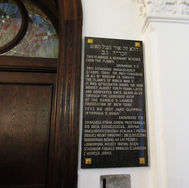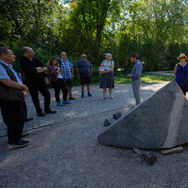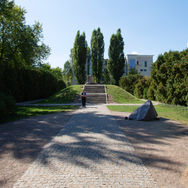top of page
ZMIDEK FAMILY
Warsaw

Map of the Warsaw Ghetto and existing part of the ghetto wall

Commemorative plaque Ghetto wall
photo : Thomas / Sue

Remnant of the ghetto wall
Plaque donated by the United States Holocaust Memorial Museum (USHMM)

Original building from the ghetto
Walicow street

Original building in the ghetto
Walicow street. The white arrow indicates the building had a basement that was used as an air raid shelter.

Remnant of the ghetto wall
Near Zlota street

Remnant of the ghetto wall
Near Sienna street

Remnant of the ghetto wall
Near Sienna street. Tomasz is describing the significance of the wall to us.

Sue and Marq
photo : Thomas

Nozyk synagogue.
The only prewar synagogue existing in Warsaw today
photo : Thomas / Sue
photo : Thomas / Sue

Nożyk Synagogue
photo : Thomas / Sue

Nozyk synagogue
The only prewar synagogue existing in Warsaw today

from the womens gallery , Nozyk synagogue
photo : Thomas / Sue

Nozyk synagogue

Marq inside the Nozyk synagogue

Nozyk synagogue

Inside the Nozyk synagogue

Monument to Ghetto Heroes
Monument commemorating the fighters of the Warsaw ghetto uprisng 19th April - 16th May 1943
the monument is made from materials brought to Warsaw by the Nazis for the construction works of Albert Speer
photo : Thomas / Sue

Listening to Tomasz by the Monument to Ghetto Heroes
photo : Thomas / Sue

Mila 18 memorial
The site of the bunker used as the headquarters for the Jewish Combat Organisation (ZOB) during the Ghetto Uprising
On May 8, 1943, three weeks after the start of the Warsaw Ghetto Uprising, the bunker was discovered by the Nazis. There were around 300 people inside. The smugglers surrendered but the ŻOB command, including Mordechaj Anielewicz, the leader of the uprising, stood firm. The Nazis threw tear gas into the shelter to force the occupants out. Anielewicz, and many of his fighters committed mass suicide by ingesting poison rather than surrender.
The bodies were never exhumed and the site today is both a memorial and a grave.
On May 8, 1943, three weeks after the start of the Warsaw Ghetto Uprising, the bunker was discovered by the Nazis. There were around 300 people inside. The smugglers surrendered but the ŻOB command, including Mordechaj Anielewicz, the leader of the uprising, stood firm. The Nazis threw tear gas into the shelter to force the occupants out. Anielewicz, and many of his fighters committed mass suicide by ingesting poison rather than surrender.
The bodies were never exhumed and the site today is both a memorial and a grave.

Reciting Kaddish at Mila 18

Mila 18 memorial

Mila 18 memorial
All the names of the fighters known to have died here appear on the memorial

Yitzhak Suknik (or Sukenik)
Yitzhak's grandmother Mariam was David Zmidek's sister.
Yitzhak fought alongside, and saved the life of Mordechaj Anielewicz, leader of the ZOB.
On May 7, he and a small party left the bunker via the sewers to make contact with others outside the ghetto to try to find an escape route out of the ghetto. The group was ambushed when they exited the sewers and most were killed.
Yitzhak fought alongside, and saved the life of Mordechaj Anielewicz, leader of the ZOB.
On May 7, he and a small party left the bunker via the sewers to make contact with others outside the ghetto to try to find an escape route out of the ghetto. The group was ambushed when they exited the sewers and most were killed.

Jeff at Mila 18.
The memorial, a small mound, is made from the rubble of the building that once stood here
bottom of page